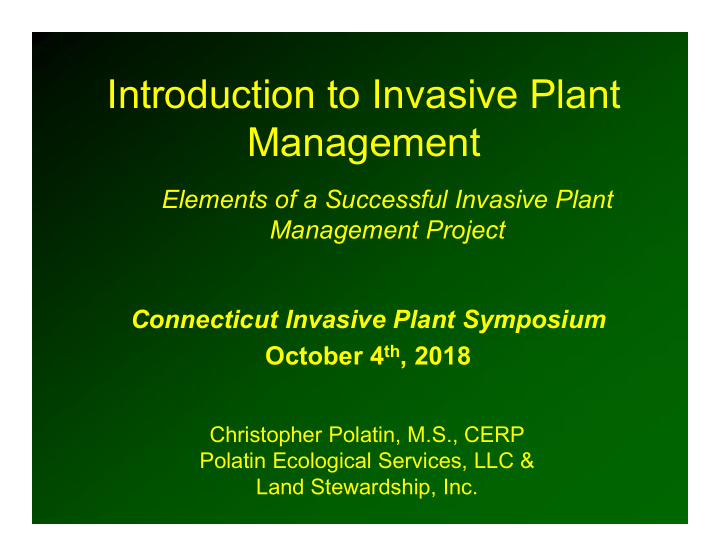



Introduction to Invasive Plant Management Elements of a Successful Invasive Plant Management Project Connecticut Invasive Plant Symposium October 4 th , 2018 Christopher Polatin, M.S., CERP Polatin Ecological Services, LLC & Land Stewardship, Inc.
Topics to cover • Elements of an effective invasive plant management program – Mapping (monitoring/record Keeping) – Prioritization • Integrated Management – Manual/Mechnical – Judicious herbicide use – Revegetation/Restoration
Elements of a Successful Project Planning Framework • Goals- articulate intention for site • Planning (Management Plan) • Site Analysis • Mapping • Prioritization • Initial, Follow-ups, ongoing Stewardship program • Early Detection • Success Criteria • Monitoring • Management Documentation • Revegetation & Ecological Restoration Considerations
Mapping • Invasive species • Distribution • Area (acres or square footage) • Density (cover class) • Size: diameter & height (plant type/age: seeding, sapling, etc.) • Non-target/native vegetation • Sensitive resource areas (wetlands/NHESP)
Glossy Buckthorn Small tree (> 7 ’ tall)
Glossy Buckthorn Shrub (< 7’)
Glossy Buckthorn Seedling (< 2’)
Prioritization E arly D etection R apid R esponse
Weed Infestations & Control Potential (1) (2) (3) (4) Eradication unlikely, intense effort required Eradication feasible Prevention Local control and or management only Eradication simple Public awareness typically begins Control Costs Infested Introduction Acres Detection few Many At or near biological potential Absent or off- locations locations site Time Modified from Chippendale 1991; Hobbs & Humphries 1995
Seedlings Common buckthorn Japanese barberry Bittersweet Japanese knotweed
Integrated Management The Importance of Timing Management Activities May/June (Droege, 1996 )
Level 1: Manual Methods
Hand-pulling
Community/Volunteers/Partners/Stakeholders
Level 2
Judicious Herbicide Use • Integrate management activities (cutting, mowing, etc.). • Use selective herbicide methods that minimize amount used. • Timing to maximize effectiveness of treatment • Glyphosate & Triclopyr (active ingredients) based general use herbicides . • Always read and follow the label directions, safety & environmental precautions.
Cut Stem/Stump Application • 20%-50% glyphosate product in water (apply immediately after cutting). • Timing: Anytime, but sap season. Wait till late spring/early summer
Mechanical Methods Small-Medium Scale
IP Success Criteria 1. Year 1. Initial treatments (combination of mechanical and chemical) results in 90% control. 2. Year 2. The first follow-up treatment (targeted chemical) results in 95% control. 3. Year 3. The second follow-up (manual or targeted chemical) results in 99% control. 4. Annual Stewardship and Maintenance (primarily manual) maintains 99% control.
Upland IP Management 2011 2012 2014 2013
Active Revegetation
Wetland IP Management 2008 2009 2010 2011 2012
Glyphosate (Roundup, Rodeo, etc.) • Derivation of glycine, an amino acid • Inhibits an essential plant enzyme (EPSP synthase). • Blocks production of aromatic amino acids: phenylalanine, tryptophan, tyrosine • Non-selective herbicide • Systemic – translocates to meristems/roots. • Gradual yellowing (chlorosis) – newest leaves first. • Non-volatile, but still need to avoid spray drift.
Glyphosate – Environmental Fate • Very stong adsorption (binding) to soil particles: • No herbicidal activity in soil (inactivated). • Not mobile in soil. • Minimal potential for leaching into groundwater or contamination of surface waters via runoff. • Readily biodegraded by bacteria, fungi • Half life in soil: generally short, but variable. • Very low toxicity to most non-target organisms. • Due to surfactants in most glyphosate products – Not approved for aquatic sites. • Rodeo, AquaPro formulations approved for water.
Triclopyr (Garlon, Renovate, Tahoe) • Disrupts normal plant hormone (auxin) function – abnormal elongation & division of plant cells. • Selective herbicide – most grasses, sedges tolerant. • Controls broadleaf weeds, woody plants. • Systemic –translocates to meristems/roots. • Initial symptoms appear rapidly – distorted growth (leaf cupping, stem twisting). • Formulations: Ester (Garlon 4) more volatile than amine (Garlon 3A).
Recommend
More recommend